We use the parametric curve formula to get the length of a polar curve. that is, we had a formula for the length of a parametric curve. It was:
[dx/d
Therefore the length of a polar curve is the following occasionally useful formula:
| Math 152 diary, spring 2007 |
|---|
| In reverse order: the most recent material is first. |
| Monday, April 30 | (Lecture #26) |
|---|
Length of polar curves
We use the parametric curve formula to get the length of a polar
curve. that is, we had a formula for the length of a parametric
curve. It was: ![]() tSTARTtEND
sqrt([dx/dt]2+[dy/dt]2
)dt. In the case of a polar curve, where
r=f(
tSTARTtEND
sqrt([dx/dt]2+[dy/dt]2
)dt. In the case of a polar curve, where
r=f(![]() ), some cute "accidents"
happen and a rather neat formula results. The connection between x and
y and the parameter
), some cute "accidents"
happen and a rather neat formula results. The connection between x and
y and the parameter ![]() is
indirect. First, x=r cos(
is
indirect. First, x=r cos(![]() ) and y=r sin(
) and y=r sin(![]() ),
so x=f(
),
so x=f(![]() )cos(
)cos(![]() ) anbd y=f(
) anbd y=f(![]() )sin(
)sin(![]() ). Then dx/d
). Then dx/d![]() =f´(
=f´(![]() )cos(
)cos(![]() )+f(
)+f(![]() )(-sin(
)(-sin(![]() )) and
dy/
)) and
dy/![]() =f´(
=f´(![]() )sin(
)sin(![]() )+f(
)+f(![]() )cos(
)cos(![]() ), so that
), so that
[dx/d![]() ]2+[dy/d
]2+[dy/d![]() ]2=Please see P. 682 of the textbook!=[dr/
]2=Please see P. 682 of the textbook!=[dr/![]() ]2+r2.
]2+r2.
Therefore the length of a polar curve is the following occasionally
useful formula:
![]()
![]() START
START![]() END
sqrt([dr/d
END
sqrt([dr/d![]() ]2+r2
)d
]2+r2
)d![]() .
.
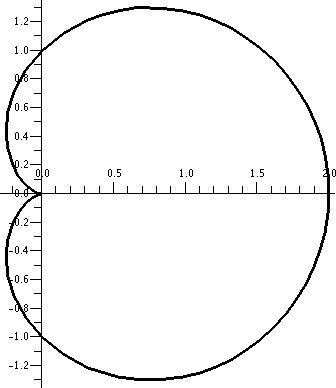 Example: length of a cardioid
Example: length of a cardioid
Let's find the length of
r=1+cos(![]() ) (today, cosine
curves -- we did a bunch of sine curves last time!). This means computing
) (today, cosine
curves -- we did a bunch of sine curves last time!). This means computing
![]() 02Pi
sqrt(r2+(dr/d
02Pi
sqrt(r2+(dr/d![]() )2)d
)2)d![]() .
.
Let's see what's inside the square root. Since r=1+cos(![]() ), dr/d
), dr/d![]() =-sin(
=-sin(![]() ), so let's square and sum them:
), so let's square and sum them:
r2+(dr/d![]() )2=
(1+cos(
)2=
(1+cos(![]() ))2+(-sin(
))2+(-sin(![]() ))2 =1+2cos(
))2 =1+2cos(![]() )+(cos(
)+(cos(![]() ))2+(sin(
))2+(sin(![]() ))2=2+2cos(
))2=2+2cos(![]() ).
).
We need to integrate the square root of that! How can we do this? Let's look at the formula sheet for the final exam.
After some struggle, we saw that 2+2cos(![]() )=4(cos((
)=4(cos((![]() /2))2. The actual integral involved some
irritation, because one needs to realize that sqrt(A2) is
|A| and is not always A!
/2))2. The actual integral involved some
irritation, because one needs to realize that sqrt(A2) is
|A| and is not always A!
Length of a weird curve
r=1/cos(![]() ) from t=0 to
t=Pi/4. A student pointed out that this was r=sec((
) from t=0 to
t=Pi/4. A student pointed out that this was r=sec((![]() ). Then we computed the integral
). Then we computed the integral
![]() 0Pi/4
sqrt(r2+(dr/d
0Pi/4
sqrt(r2+(dr/d![]() )2)d
)2)d![]() .
Here we needed various formulas about secants and tangents. Why, to
get them we looked at the formula sheet for the final
exam..
.
Here we needed various formulas about secants and tangents. Why, to
get them we looked at the formula sheet for the final
exam..
Of course the instructor then revealed that the "curve" was rcos(![]() )=1, or x=1. We had just found the
length of a line segment joining (1,0) and (1,1). It should be 1 and
it was 1.
)=1, or x=1. We had just found the
length of a line segment joining (1,0) and (1,1). It should be 1 and
it was 1.
Area in polar coordinates
From the area of a pie slice to the area of a blob.
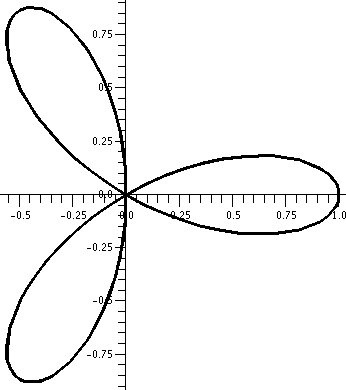 Sketching a rose
Sketching a rose
r=cos(3![]() ). Area inside one petal?
Well, cos(3
). Area inside one petal?
Well, cos(3![]() ) "first" (going
from 0 to 2Pi) is 0 when 3
) "first" (going
from 0 to 2Pi) is 0 when 3![]() )=Pi/2. So we get half a petal by integrating from 0 to
Pi/6. The formula is
)=Pi/2. So we get half a petal by integrating from 0 to
Pi/6. The formula is ![]() AB(1/2)r2d
AB(1/2)r2d![]() so this becomes (for the whole petal, we need to double):
so this becomes (for the whole petal, we need to double):
2·(1/2)![]() 0Pi/6 cos(3
0Pi/6 cos(3![]() )2d
)2d![]() . How can we do this integral?
Let's look at the formula sheet for the final exam.
. How can we do this integral?
Let's look at the formula sheet for the final exam.
On the formula sheet we are advised that
A last link!
If you wish to see dyamically (!) how some roses are drawn
(r=cos(3![]() ) and r=cos(4
) and r=cos(4![]() )) then
)) then
GO HERE but
Warning! the files are quite large, and
may take a while to load.
| Wednesday, April 25 | (Lecture #25) |
|---|
"Standard issue" polar coordinates
An example and the problem with polar coordinates
Common restrictions on polar coordinates and the problems they have
Conversion formulas
Specifying regions in the plane in polar fashion
Graphing polar functions
A collection of examples
|
Let's consider r=3+sin( The picture to the right shows the curve in black. I'd describe the curve as a slightly flattened circle. The flattening is barely apparent to the eye, but if you examine the numbers, the up/down diameter of the curve is 6, and the left/right diameter is 6.4. | 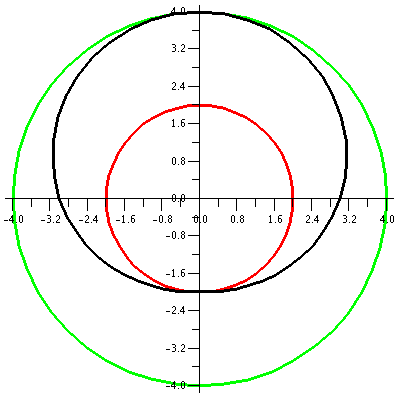
|
|
Now consider r=2+sin( Here the "deviation" from circularity in the curve is certainly visible. The bottom seems especially dented. | 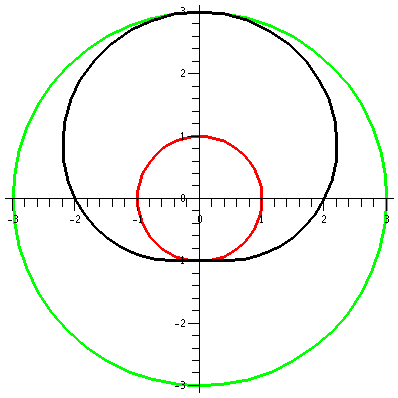
|
We decrease the constant a bit more, and look at r=1+sin(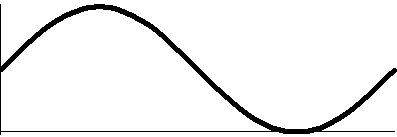 The rectangular graph of 1+sine, shown here, decreases
down to 0 and then increases to +1. The polar graph dips to 0 and then
goes back up to 1. The dip to 0 in polar form is geometrically a sharp
point! I used "!" here because I don't believe this behavior is easily
anticipated. The technical name for the behavior when r=3Pi/2 is
cusp. The rectangular graph of 1+sine, shown here, decreases
down to 0 and then increases to +1. The polar graph dips to 0 and then
goes back up to 1. The dip to 0 in polar form is geometrically a sharp
point! I used "!" here because I don't believe this behavior is easily
anticipated. The technical name for the behavior when r=3Pi/2 is
cusp.
This curve is called a cardioid from the Latin for "heart" because if it is turned upside down, and if you squint a bit, maybe it sort of looks like the symbolic representation of a heart. Maybe. | 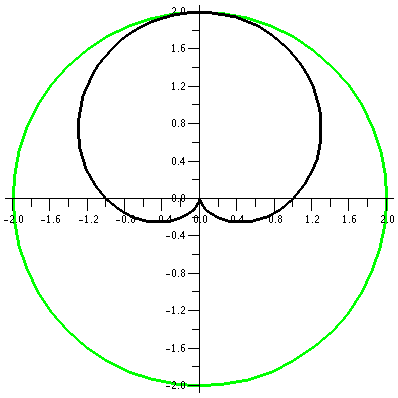
|
Here's the final curve we'll consider in this family: r=1/2+sin( The rectangular graph on the interval [0,2Pi] of sine moved up by 1/2
shows that this function is 0 at two values, and is negative between
two values. The values are where 1/2+sin(
The rectangular graph on the interval [0,2Pi] of sine moved up by 1/2
shows that this function is 0 at two values, and is negative between
two values. The values are where 1/2+sin(This curve is called a limacon. The blue lines are lines with | 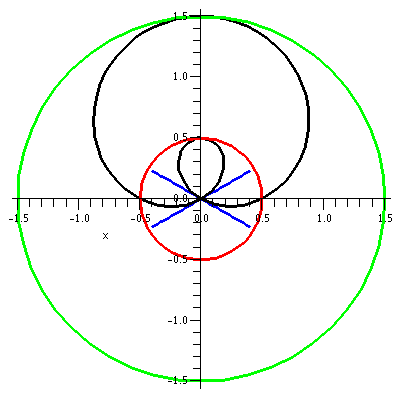
|
More information about these curves is available here
Exponential?
Snails
| Monday, April 23 | (Lecture #24) |
|---|
Announcements
Teaching evaluations will be requested at the next class meeting.
Here is information about
final exam, including review material, review sessions, and the date, time, and place of the examination.
Parametric curves
We begin our rather abbreviated study of parametric curves. These
curves are a rather clever way of displaying a great deal of
information. Here both x and y are functions of a parameter. The
parameter in your text is almost always called t. The simplest
physical interpretation is that the equations describe the location of
a point at time t, and therefore the equations describe the motion of
a point as time changes. I hope the examples will make this more
clear.
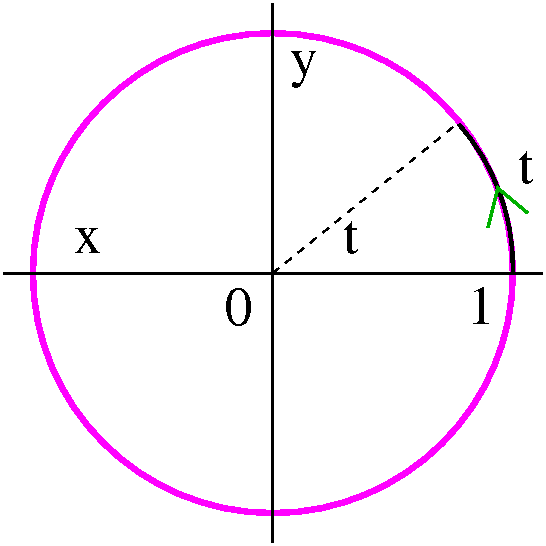 Example 1
Example 1
Suppose x(t)=cos(t) and y(t)=sin(t). I hope that you recognize almost
immediately that x and y must satisfy the equation
x2+y2=1, the standard unit circle, radius 1,
center (0,0). But that's not all the information in the equations.
The point (x(t),y(t)) is on the unit circle. At "time t" (when the parameter is that specific value) the point has traveled a length of t on the unit circle's curve. The t value is also equal to the radian angular measurement of the arc. This is uniform circular motion. The point, as t goes from -infinity to +infinity, travels endlessly around the circle, at unit speed, in a positive, counterclockwise direction.
Example 2
Here is a sequence of (looks easy!) examples which I hope showed
students that there is important dynamic (kinetic?) information in the
parametric curve equations which should not be ignored.
| 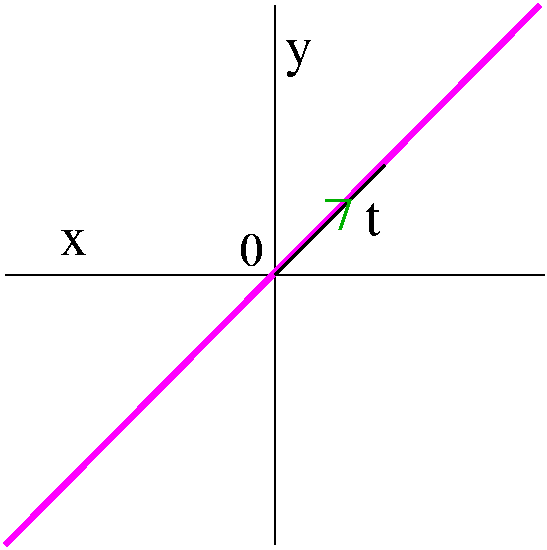
|
| 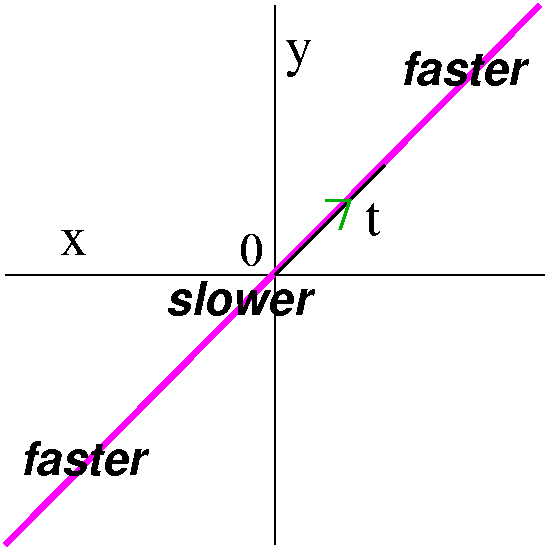
|
| 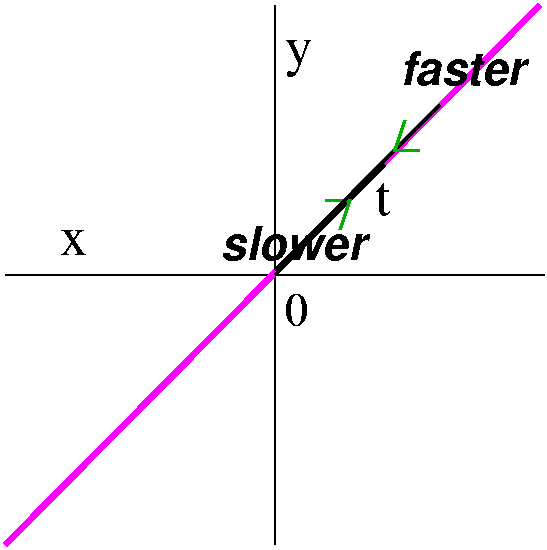
|
| 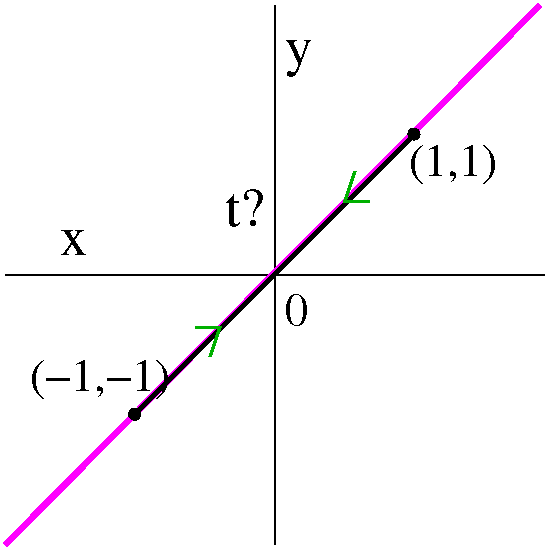
|
Example 3
|
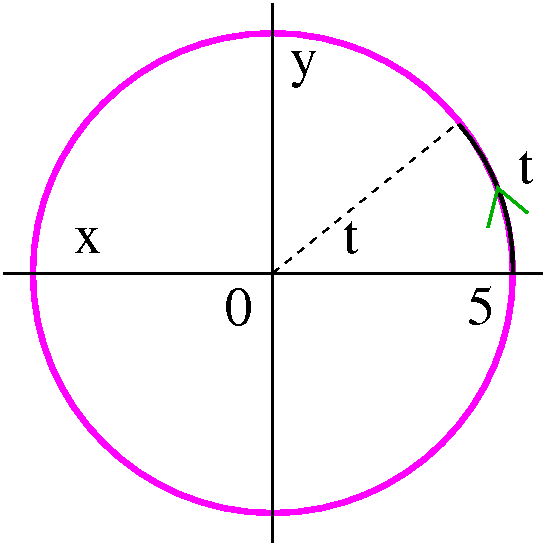
|
| 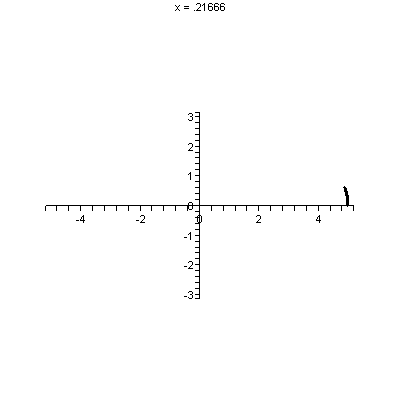
|
A bug drawing out a thread ...
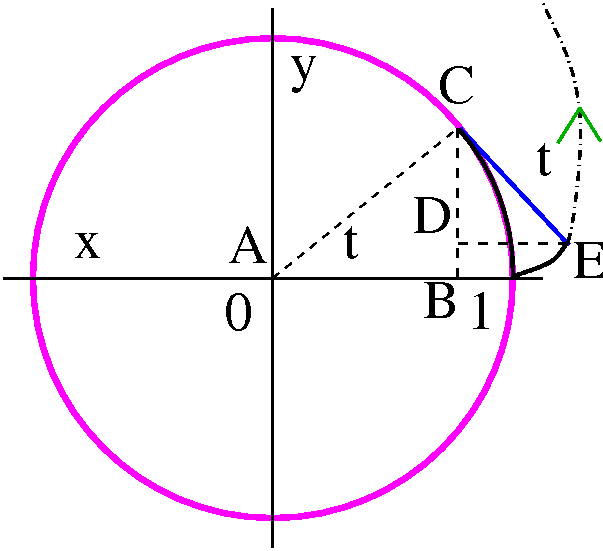 Thread is wound around the unit circle centered at the origin. A bug
starts at (1,0) and is attached to an end of the thread. The bug
attempts to "escape" from the circle. The bug moves at unit speed.
Thread is wound around the unit circle centered at the origin. A bug
starts at (1,0) and is attached to an end of the thread. The bug
attempts to "escape" from the circle. The bug moves at unit speed.
I would like to find an expression for the coordinates of the bug at time t. Look at the diagram. The triangle ABC is a right triangle, and the acute angle at the origin has radian measure t. The hypoteneuse has length 1, and therefore the "legs" are cos(t) (horizontal leg, AB) and sin(t) (vertical leg, BC). Since the line segment CE is the bug pulling away (!) from the circle, the line segment CE is tangent to the circle at C. But lines tangent to a circle are perpendicular to radial lines. So the angle ECA is a right angle. That means the angle ECD also has radian measure t. But the hypoteneuse of the triangle ECD has length t (yes, t appears as both angle measure and length measure!) so that the length of DE is t sin(t) and the length of CD is t cos(t).
The coordinates of E can be gotten from the coordinates of C and the lengths of CD and DE. The x-coordinates add (look at the picture) and the y-coordinates are subtracted (look at the picture). Therefore the bug's path is given by x(t)=cos(t)+t sin(t) and y(t)=sin(t)-t cos(t).
| t between 0 and 1 | t between 0 and 10 Note the scale is changed! |
|---|---|
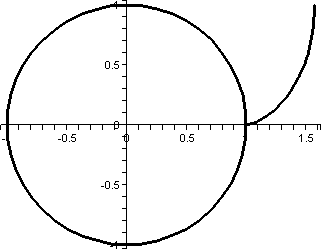 |
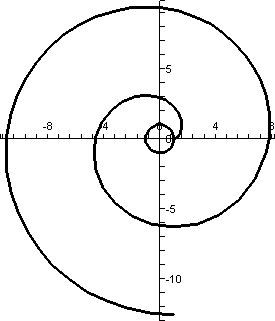 |
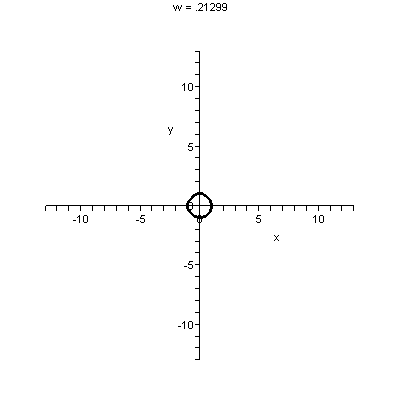 Finally to the right is an animated picture of the bug moving. Maybe
you can understand this picture better: maybe (!!).
Finally to the right is an animated picture of the bug moving. Maybe
you can understand this picture better: maybe (!!). Slopes of secant and tangent lines
Here we use a sort of Taylor approximation to get a useful formula for
the slope of a line tangent to a parametric curve.
Tangents at the self-intersection
Length of a path
How useful is it?
Example
QotD
What is the state bird of New Jersey?
I am happy to report that about two-thirds of the registered students
answer this question. More than half (barely!) reported the correct
answer: the Eastern Goldfinch. New Jersey "shares" this state bird
with Iowa. The next most common answer was Cardinal, which is the
state bird for 6 other states. Some of the other answers were rather
bizarre.
animate
| Thursday (!), April 19 | ("Lecture #23") |
|---|
Taylor's Theorem with Lagrange's form of the remainder
There is some number c between a and x so that f(x)=![]() j=0n[f(j)(a)/j!](x-a)j + [f(n+1)(c)/(n+1)!]{(x-a)n+1.
j=0n[f(j)(a)/j!](x-a)j + [f(n+1)(c)/(n+1)!]{(x-a)n+1.
Yet another Taylor series example but different
Suppose f(x)=sqrt(x) or, if you wish, f(x)=x1/2. Then
f´(x)=(1/2)x-1/2 and
f(2)(x)=(1/2)[-(1/2)]x-3/2 and
f(3)(x)=(1/2)[-(1/2)][-(3/2)]x-5/2, etc.
So this all looks "o.k." except there is one slight problem. I mentioned that most people like to apply Taylor's Theorem with a=0, because it just seems more computationally direct. In this case, if we want to construct Taylor polynomials with a=0, that is, polynomials such as T3(x)=f(0)+f(1)(0)x+[f(2)(0)/2]x2+[f(3)(0)/6]x3, we will have a difficult time because, for example, f(2)(x)=-(1/4)x-3/2, and plugging in x=0 gives an expression involving division by 0. This is not good.
One possible workaround
"A workaround is a method, sometimes used temporarily, for
achieving a task or goal when the usual or planned method isn't
working."
What can we do here? Well, one "solution" is to choose another a. We
should take a value of a which would make the Taylor polynomials easy
to calculate. One choice is a=1 instead of a=0. Then the values of the
derivatives, which all look like
{One constant}xSome other constant, become
{One constant} because 1Some other constant is
1. So if a=1 we get:
f(1)=11/2=1 and
f(1)(1)=(1/2)1-1/2=1/2 and
f(2)(1)=(1/2)[-(1/2)]1-3/2=-1/4 and
f(3)(1)=(1/2)[-(1/2)][-(3/2)]1-5/2=3/8, etc.
We can use these numbers to "construct" our Taylor polynomials, but
remember that the polynomials have (x-a)'s in them. So, for example,
we would have
T3(x)=f(1)+f(1)(1)(x-1)+[f(2)(1)/2](x-1)2+[f(3)(1)/6](x-1)3=
1+(1/2)(x-1)+[-(1/4)/2](x-1)2+[(3/8)/6](x-1)3=
1+(1/2)(x-1)-(1/8)(x-1)2+(1/16)(x-1)3
(By the way, the next term is -(5/128)(x-1)4 so the coefficients are not as simple as the first few seem to be!)
So we could do this. People really do like to have a=0, so they
frequently do something else, and it is this something else which is
done in your textbook.
Another possible workaround
Instead of looking at the function f(x)=x1/2 with a=1,
move the function so we can still take a=0. So let us change
the function to f(x)=(1+x)1/2, and then:
f(x)=(1+x)1/2 so f(0)=(1+0)1/2=1
f(1)(x)=(1/2)(1+x)-1/2 so
f(1)(0)=(1/2)(1+0)-1/2=(1/2)
f(2)(x)=(1/2)[-(1/2)](1+x)-3/2 so f(0)=(1/2)[-(1/2)](1+0)-3/2=-(1/4)
f(3)(x)=(1/2)[-(1/2)][-(3/2)](1+x)-5/2 so f(0)=(1/2)[-(1/2)][-(3/2)](1+0)-5/2=(3/8)
Now T3(x) will be a polynomial centered at a=0.
T3(x)=f(0)+f(0)(0)(x-0)+[f(2)(0)/2](x-0)2+[f(3)(0)/6](x-0)3=
1+(1/2)x+[-(1/4)/2]x2+[(3/8)/6]x3=
1+(1/2)x-(1/8)x2+(1/16)x3.
Of course the polynomials we get are essentially the same as in the first workaround: we get the same sequence of coefficients, and have just replaced the x-1's by x-0's (that is, x's).
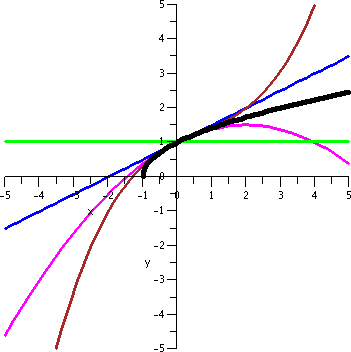 What happens?
What happens?
To the left is one graph of f(x)=x1/2. The x-values
are the interval [-5,5]. This is a bit silly, because the domain of
the function is just [-1,infinity], so the graph is half of a parabola
in black. What are the other curves? I have colored the curves to correspond to various formulas, so
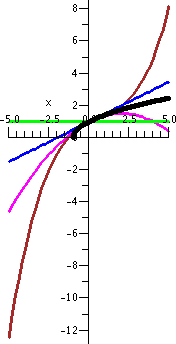 The series tries to converge in some interval which looks like
(-something,+something). But what it tries to converge to is only
defined in (-1,infinity). So ... it turns out that this Taylor series
will converge only in (-1,1). You can see what happens for, say,
x=4. The values of the Taylor polynomials alternately are over and
under the true value of the function and the values get farther away
from the function, not closer!
The series tries to converge in some interval which looks like
(-something,+something). But what it tries to converge to is only
defined in (-1,infinity). So ... it turns out that this Taylor series
will converge only in (-1,1). You can see what happens for, say,
x=4. The values of the Taylor polynomials alternately are over and
under the true value of the function and the values get farther away
from the function, not closer!
Here is another picture of the same curves. This is maybe a more honest picture. In the first picture, my window was [-5,5] in both the horizontal and vertical directions. Here I have let the vertical dimension be determined by the graphs of the functions, that is, what the ranges of the five functions are on [-5,5]. So you can see how badly the third degree Taylor polynomial makes things look.
Higher degree Taylor polynomials make things even worse for x's which are not in the interval from -1 to 1. So this is a much more subtle phenomenon than for sine or cosine or exponential.
sqrt(1.5)
Well, let's look at an example. Suppose I wanted to compute sqrt(1.5)
using Taylor polynomials. By the way, this is definitely not
realistic. Newton's method is much more efficient computationally. I
could try x=.5 and f(x)=(1+x)1/2 and n=3. I'm using n=3
because we already have T3(x). So:
sqrt(1.5)=T3(.5)+Error.
What is the error? Taylor's Theorem states that it is determined by
f(4)(c)|x|4/4!. We already computed the third
derivative, and it was f(3)(x)=(3/8)(1+x)-5/2 so
that f(4)(x)=-(15/16)(1+x)-7/2. How big can this
be in absolute value? Well,
|-(15/16)(1+x)-7/2|=(15/16)/(1+x)7/2: the x-stuff is on the
bottom. x ranges from a=0 to x=.5, Since the power is on the bottom,
the 4th derivative is decreasing. The largest it can be is at 0, so the largest |f(4)(c)| can be is (15/16). The other stuff,
|x|4/4!, since x=.5, becomes
(.5)4/4!=1/[16·24]=1/384. So the largest the absolute
value of the error can be is (15/16)(1/384)=5/2048 which is about .0025. Notice also that the sign of the error is negative, so I bet that T3(.5) will overestimate sqrt(1.5).
The "true" value of sqrt(1.5) is 1.224744871 and T3(1.5)=1.226562500. The approximation error is -0.001817629, so the approximation is an overestimate, and the size of the error is about what I predicted.
So why do people study this?
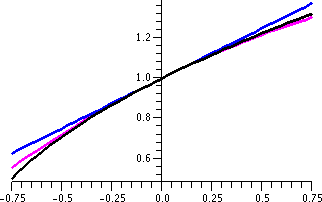 People rarely use these approximations to compute specific values of
square root. Newton's method is much more efficient. But they do use
these ideas to think about square root. If |x| is small, then
sqrt(1+x) is approximately 1+(1/2)x. This is an overestimate, and the
size of the error will be about (1/8)x2. If you need a
better approximation, then I think when |x| is small, that sqrt(1+x)
is approximately 1+(1/2)x-(1/8)x2.
The error will be about (1/16)x3 (positive error for x>0 and negative error when x<0).
People rarely use these approximations to compute specific values of
square root. Newton's method is much more efficient. But they do use
these ideas to think about square root. If |x| is small, then
sqrt(1+x) is approximately 1+(1/2)x. This is an overestimate, and the
size of the error will be about (1/8)x2. If you need a
better approximation, then I think when |x| is small, that sqrt(1+x)
is approximately 1+(1/2)x-(1/8)x2.
The error will be about (1/16)x3 (positive error for x>0 and negative error when x<0).
The graph to the right shows the three curves in the interval [-.75,.75].
A more intricate (and more realistic!) example
For example, suppose you needed to study a function like
sqrt(1+sin[Ax]) for varying values of the parameter A but for small
values of x. This sort of function might occur (does occur!) when you
consider small motions of a pendulum. How would you expect the
function to behave when A changes? Well, if x is small, Ax is small,
and then sin(Ax) will be small. So I would guess that
sqrt(1+sin[Ax]) would equal (approximately!)
1+(1/2)sin(Ax)-(1/8)(sin[Ax])2 and then maybe I might think
that sin(Ax) would equal (approximately!) Ax-(Ax)3/6 if x
is small (first few times of the Taylor series for sine) so that
sqrt(1+sin[Ax]) would equal (approximately!)
1+(1/2)[Ax-(Ax)3/6]-(1/8)[Ax-(Ax)3/6]2=1+(A/2)x-(A/12)x3-(1/8)(Ax)3
 I am discarding terms of degree >3 because maybe for small x they
won't matter too much. Then I bet that
I am discarding terms of degree >3 because maybe for small x they
won't matter too much. Then I bet that
sqrt(1+sin[Ax]) and
1+(A/2)x-[(3A3+2A)/24]x3 agree well when x is
small. To the right is a graph of both curves when x=.5 and A is in
the interval [-1,1]. Although this x is not too small, the agreement
is still fairly good.
You might think such an example is silly, but it won't be silly if you
are trying to adjust the parameter A (which might describe, fo0r
example, some aspect of a material or a solution) to fit some
requirement. Computing low degree polynomials is much easier than
working with a composition of square root and sine.
How about (1+x)1/3?
If f(x)=(1+x)1/3, then:
f(0)=1
f(1)(x)=(1/3)(1+x)-2/3 so f(1)(0)=(1/3)
f(2)(x)=(1/3)[-(2/3)](1+x)-2/3=-2/9(1+x)-5/3.
I bet that (1+x)1/3 is approximately 1=(1/3)x when |x| is
small. The error or remainder is f(2)(c)x2/2
which is -1/9(1+c)-5/3x2.
If x=.05, then (1+.05)1/3=1.016396357
and
1+(1/3)(.05)=1.016666667.
Now with c between 0 and .05, (1+c)-5/3 will be at most 1 since again this is a negative power. I bet that the absolute value of the error will be at most (1/9)(.05)2=0.0002777777778.
Actually, 1.016396357=1.016666667+ERROR, and so
ERROR=-0.000270310. The error is negative because of
the sign in front of f(2)(c).
So 1+(1/3)x is a good approximation to (1+x)1/3, with error roughly -1/9x2. If I desperately wanted a better local approximation near x=0, I would use T2(x), which would be 1+(1/3)x-(1/9)x2, and I would expect the error (when x is small and positive) to be about (10/162)x3. Where did the 10/162 come from? Since f(2)(x)=-2/9(1+x)-5/3, f(3)(x)=-2/9[-(5/3)](1+x)-8/3=10/27(1+x)-8/3. For x small and positive, this is at most 10/27. But we need to multiply this (for the Taylor error) by x3/3!=(1/6)x3. This gets us (10/162)x3.
Confession
I would not expect to use these ideas very often. But I should keep
them in the back of my brain. When I want to approximate a weird
function "locally" by a polynomial, the Taylor polynomials are really
the first thing to try.
sqrt(17)
The square root of 16 is 4. What can be done to approximate sqrt(17)?
Well, sqrt(16+1)=4sqrt(1+{1/16})=[approx]4(1+(1/32))=4.125, while the
"true value" is about 4.123. Amazing! The correction will
have a negative sign as we could predict (from -1/8x2).
(1+x)m
Now (1+x)m will be about 1+mx for small x, with correction
[m(m-1)/2]x2, etc.
Section 11.11, problem 11
The first part of the problem is "Use the binomial series to expand
1/sqrt(1-x2)." Page 773 of the text has "The Binomial
Series". The result is:
If k is any real number and |x|<1, thenThe symbol (kn) is supposed to be a binomial coefficient, and it certainly looks ugly typed is standard html, which is what I am using. It means the product k(k-1)(k-2)...(k-n+1) (n factors) divided by n!. I will just write out the first few terms, because the binomial coefficients look too silly here.
(1+x)k=1+kx+[k(k-1)/2!]x2+[k(k-1)(k-2)/3!]x3+...
=k=0infinity(kn) for n>0 and (k0)=1.
Back to the solution of problem 11. Let me first take k=-1/2. Then the Binomial Theorem states: (1+x)-1/2=1-(1/2)x+(3/8)x2-(5/16)x3+... (I did some arithmetic away from this record because I am getting tired of typing!). Now let me substitute -x2 for x. The result is: (1-x2)-1/2=1+(1/2)x2+(3/8)x4+(5/16)x6+...
The second part of the problem has this request: "Use part a) to find
the Maclaurin series for arcsin(x)." I know that the integral from 0
to x of 1/sqrt(1-x2) is arcsin(x) (because arcsin(0)=0). So
I will just integrate the answer to a) and make the integration
constant equal to 0. Here is the result:
arcsin(x)=x+(1/6)x3+(3/40)x5+(5/112)x7+...
Comment If I wanted to compute values of arcsin, I would probably use this series. For example (10 digit accuracy) arcsin(.5)=0.5235987756 and the value of the seventh degree polynomial above when x=.5 is 0.5235258556 and that's not too far off for almost no work!
Section 11.11, problem 13
Part a) is "Expand (1+x)1/3 as a power series." So this is
the Binomial Theorem with k=1/3. Here are some terms (again, work done
away from this page):
(1+x)1/3=1+(1/3)x-(1/9)x2+(5/81)x3-(10/243)x4+...
Part b) asks for an estimation of "(1.01)1/3 correct to four decimal places." I looked at the result above, and I think the series is alternating (the numbers f(j)(0) change sign because (1+x)something negative brings "down" a negative multiplier each time). Since the series is alternating, I can estimate the accuracy by just looking at the first omitted term. Hey, (5/81)(.01)3 will be less than .0001, so I bet that (1.01)1/3 to 4 decimal place accuracy is 1+(1/3)(.01)-(1/9)(.01)2.
Indeed, I am told (10 digit accuracy) that (1.01)1/3 is 1.003322284 and 1+(1/3)(.01)-(1/9)(.01)2 is 1.003322222. To me this is pretty darn good (8 digits!) for almost no work.
Section 11.11, problem 18
First, "Use the binomial series to find the Maclaurin series of
f(x)=1/sqrt(1+x3)." I will break this into two steps. First
I will use the Binomial Theorem with k=-1/2:
(1+x)-1/2=1-(1/2)x+(3/8)x2-(5/16)x3+...
Then I will plug in (pardon me: "substitute") x3 for x:
(1+x3)-1/2=1-(1/2)x3+(3/8)x6-(5/16)x9+...
Part b) asks for the value of f(9)(0). Now I know that the coefficient of x9 in the power series will be equal to f(9)(0)/9!, so I look at the answer I just got, and see that this is -(5/16). Therefore f(9)(0) must be -(5/16)9!.
This number turns out to be -113,400, and you would not want to get it by directly computing the ninth derivative of 1/sqrt(1+x3) because that is
18 15 12 9
678264862275 x 119693799225 x 31031725725 x 7161167475 x
- ---------------- + ---------------- - --------------- + --------------
3 19/2 3 17/2 3 15/2 3 13/2
512 (1 + x ) 32 (1 + x ) 8 (1 + x ) 4 (1 + x )
6 3
699238575 x 21432600 x 113400
- -------------- + ----------- - -----------
3 11/2 3 9/2 3 7/2
2 (1 + x ) (1 + x ) (1 + x )
logarithm
The function ln has bad behavior at x=0, so people usually move the
function in order to keep the series centered at 0 (people are
stubborn!). Since ln(1+x) has derivative 1/(1+x), its series can be
gotten by integrating the series for 1/(1+x)= (geometric!)
1-x+x2-x3+x4-x5+.... If we
integrate the series we get
x-(1/2)x2+(1/3)x3-(1/4)x4+(1/5)x5-x5+....+C. What is the correct value of C? When x=0, ln(1+x) becomes ln(1+0)=ln(1)=0, so C=0. And
ln(1+x)=x-(1/2)x2+(1/3)x3-(1/4)x4+(1/5)x5-x5+....
This series is not very useful for computational purposes. For example, when x=.9, the actual value of ln(1+.9) is 0.6418538862 but the 10th partial sum of the series when x=.9 is 0.6261981044: one place accuracy, which is rather silly. There are other series, related to this one, which are used to compute values of ln.
| Wednesday, April 18 | (Lecture #22) |
|---|
Taylor's Theorem with Lagrange's form of the remainder
There is some number c between a and x so that f(x)=![]() j=0n[f(j)(a)/j!](x-a)j + [f(n+1)(c)/(n+1)!]{(x-a)n+1.
j=0n[f(j)(a)/j!](x-a)j + [f(n+1)(c)/(n+1)!]{(x-a)n+1.
We used this in easy cases
The sine and cosine functions are very much the easiest
functions. That's because we can estimate the M's as 1 (all the
derivatives of sine and all the derivatives of cosine have their
absolute values all bounded by 1). So the remainders-->0 and each
function is the sum of its Taylor series for all x's.
"Computing" e-.3
Let me describe how to compute e-.3 with an accuracy of
+/-.001:
e-.3=Tn(-.3)+remainder.
Here x=-.3 and a=0 and we want to determine n so that (if possible!) the remainder has absolute value less than .001. Here the estimate we've been using for the remainder is M|-.3|n+1/(n+1)!, and M is an overestimate of f(n+1)(x) on the interval whose endpoints are a=0 and x=-.3. But the derivative is ex (all of the derivatives are ex!) and ex is increasing on any interval. Therefore M is the value at the right-hand endpoint, and in this case this is e0=1. The error is less than 1(.3)n+1/(n+1)!. The minus signs drop out because of the absolute value. The powers of the .3 on top make things smaller, and the factorials on the bottom, which grow quickly, also help to shrink the error. I think in class we just estimated that n=7 is sufficient. I was intentionally lazy. Here are the terms of this partial sum.
| j= | Exact value | Decimal approximation | |
|---|---|---|---|
| 0 | 1 | 1 | |
| 1 | -3/10 | -0.3000000000 | |
| 2 | -9/200 | 0.04500000000 | |
| 3 | 27/80000 | 0.0003375000000 | |
| 4 | 1 | 1 | -0.00002025000000|
| 5 | 1 | 0.1012500000·10-5 | |
| 6 | 81/80,000,000 | 0.1012500000·10-5 | 7 | 1 | -0.4339285714·10-7 |
"Computing" e.3
"Computing" e3
What happens in general ...
What is the exponential function?
Computing an integral
How could we compute
![]() 01e-x2dx?
01e-x2dx?
Another series
Suppose, in a less-likely scenario, we have to find the first 5
non-zero terms of the Taylor series for (3+2x)e(x3)
A curious collection of facts
I wrote parts of the table below, and added entries as I explained
them. So, for example, I defined sinh(x) (hyperbolic sine of x,
pronounced "cinch of x") as the difference
(1/2)[ex-e-x]. To get the series for this
function, I took the series for ex and substituted in -x
for x. The result has minus signs at the odd powers. The difference of
the two series divided by 2 is the series shown. The function cosh(x)
(hyperbolic cosine of x, pronounced "cosh of x") is the average of
ex and e-x. Its series is half of the sum of the
series for each of the pieces. When the pieces are summed, the odd
powers cancel, and the result is what is shown.
The most intriguing (strange, weird?) entries in the table below occur
as a result of Euler's Formula. If you are willing to
accept that there is a number i whose square is -1, then something
strange happens as you consider eix. Notice that the powers
of i have this behavior:
i1=i and i2=-1 and i3=i·i2=-i and
i4=i·i3=i·(-i)=(-1)(-1)=1 and
...
The powers of i repeat ever four times. Therefore
eix=1+(ix)+(ix)2/2+(ix)3/6+(ix)4/24+...
eix=1+ix-x2/2-ix3/6+x4/24+...
The even terms are exactly like the series for cosine, and the odd
terms all have i, and except for that are like the series for
sine. So:
| Euler's Formula |
|---|
| eix=cos(x)+i sin(x) |
Then because sine is odd and cosine is even, e-ix=cos(x)-i sin(x). This gets the entries in the formula column for sine and cosine (add and subtract the two equations).
| Function | Formula | Differential equation
(actually, the initial value problem) | Power series |
|---|---|---|---|
| sin(x) |
eix-e-ix ---------- 2i |
y´´=-y y(0)=0 and y´(0)=1 Simple harmonic motion, init. vel. sol'n |
x-x3/3!+x5/5!+... |
| cos(x) |
eix+e-ix ---------- 2 |
y´´=-y y(0)=1 and y´(0)=0 Simple harmonic motion, init. pos. sol'n |
1-x2/2!+x4/4!+... |
| sinh(x) |
ex-e-x ---------- 2 |
y´´=y y(0)=0 and y´(0)=1 |
x+x3/3!+x5/5!+... |
| cosh(x) |
ex+e-x ---------- 2 |
y´´=y y(0)=1 and y´(0)=0 |
1+x2/2!+x4/4!+... |
Then I discussed ...
The responsibility of students to hand in work that is good. I
referred specifically to writeups of the last workshop problem. I prepared
an answer to this
problem.
I remarked that
workloads increase as students progress to more advanced courses, and
that more sophisticated study skills were needed.
I returned the second exam.
| Monday, April 9 | (Lecture #21) |
|---|
April 2007 S M Tu W Th F S 8 9 10 11 12 13 14 15 16 17 18 19 20 21 22 23 24 25 26 27 28 29 30 |
We have six more lecture meetings, including today and excluding the exam day on April 11. I propose (subject to revision if something doesn't work!) to use this time in the following way: 3 lectures dedicated to explaining uses of Taylor's Theorem, 1 lecture devoted to parametric curves, and 2 lectures devoted to calculus in polar coordinates.
Here is a restatement of Taylor's Theorem. The vocabulary will be what's generally used when people discuss Taylor's Theorem.
Taylor's Theorem with Lagrange's form of the remainder
There is some number c between a and x so that f(x)=![]() j=0n[f(j)(a)/j!](x-a)j + [f(n+1)(c)/(n+1)!]{(x-a)n+1.
j=0n[f(j)(a)/j!](x-a)j + [f(n+1)(c)/(n+1)!]{(x-a)n+1.
Silly textbook problem
What is
T4(x) for cosine centered at a=Pi/3
How to discover Taylor's Theorem
Discussion for exp, using L'H many times.
sin(.3)+/-.0001
sin(3)+/-0.0001
A strange function
sin(x)/x integrated from 0 to 1
A stranger function
sin(x)/(1-x) What is T4(x)?
QotD
What is f(4)(0) if f(x)=sin(x)/(1-x)?
Maintained by greenfie@math.rutgers.edu and last modified 4/11/2007.